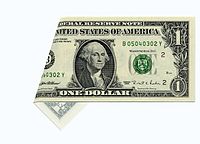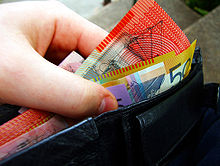- Currency bill tracking
-
Currency bill tracking is the process (usually facilitated by any one of a number of websites set up for the purpose) of tracking the movements of banknotes, similar to how ornithologists track migrations of birds by ringing them. Currency bill tracking sites can track currency among the users of that website. A user may register a bill by entering its serial number, and if someone else has already registered the bill, then the "route" of the bill can be displayed.
Some bill tracking sites encourage marking before spending, whereas others do not. This usually depends on the laws of the country issuing the currency.
The most popular currencies for currencies tracking are the Euro, the United States Dollar (USD), and the Canadian Dollar (CND).
Contents
Background
Originally beginning in the United States in the mid-1990's, the phenomenon or hobby of currency tracking quickly spread first to Canada and then beyond. Especially with the Euro bill tracking, trackers have taken on a much more competetive nature and have form communities within their respective sites. Many successful sites incorperate some sort of social media, either through site specific unique techniques, or through outside popular social media sites. In the Eurozone because multiple countries having adopted the Euro, this easily leads to competetion between trackers in different countries; in the United States cometetion plays out at the state or county level; and in Canada, at the provincial level.
Canada, once a thriving bill tracking country, has been hit hard by the introduction of cotton bills and later polymer bills, making currency tracking through marking bills nearly impossible. This trend is causing growing concern throughout currency tracking sites around the world, already having desimated New Zealand and Vietnam. In Australia, the country with the longest exposure to polymer, attempts were made in 2006 to form The Money Tracker which tracks Australian Dollars without marking of any kind. If successful, it could be huge breakthrough to the polymer problem, meaning adjustment could be made to existing tracking sites to allow the tracking of polymer banknotes. If a breakthrough is not made, it could mean the collapse of currency tracking as a result of the polymer problem.
Marking bills in Canada with ink or rubber stamp is legal. In the United States, marking is illegal; however, this is rarely enforced and only a fine is faced, if convicted. Marking is widespread in both countries. In the Eurozone marking is not universal, and varies by region.
Popular currency bill tracking websites
Some of the most popular websites for bill tracking include the following:
United States and Canada
- Where's George?, started in December 1998, was the first site to start a currency bill tracking project and remains the most popular of the sites, with nearly $1 billion worth of notes entered as of December 2010. It was created by Hank Eskin to track US$. The site has led to the creation of many other bill tracking sites.[1]
- Where's Willy? for CAD (Canada). Despite the website starting up two years after Canadian Money Tracker, it is the most popular of the Canadian currency tracking sites.[2]
- TrackDollar for US$[4]
- Canadian Money Tracker, started in 1999, for CAD (Canada)[citation needed]
Europe
Euro
- EuroBillTracker was started on January 1, 2002 to track euro banknotes. It is the largest of the euro tracking sites.[5]
- EuroTracer, the second-largest euro-tracking site, also studies the systems of serial numbers and printer codes of euro banknotes and the distribution of euro coins with their different national faces.[citation needed]
- FollowMyEuro is the third site for tracking Euro's.[citation needed]
- myEurobill, tracking euro banknotes using Google maps interface. Developed with Ruby on Rails.[citation needed]
Other
- Where's Lizzy, Find Lizzy, Cash Path[citation needed] and Fiver Finder[citation needed] track banknotes of the pound sterling. The first British currency tracking site, Doshtracker, is no longer in operation.
- CashFollow for Swiss franc.[citation needed]
- SEK-Tracker tracks Swedish kronas since 2004
-
- In 1999, Market research company Cint hosted a now defunct tracking service for 20 SEK notes, named after Selma Lagerlöf, whose portrait appears on the obverse.[6]
- Penzkoveto.hu tracks Hungarian Forints[7]
- Moja-Lova tracking Croatian kunas using Google maps interface. Developed with Google Web Toolkit and PHP.[8]
Elsewhere
- The Money Tracker started in 2006 for tracking Australian Dollars, and uniquely tracks banknotes using an interactive map of Australia
- Where's my Bucks started tracking South African rands in 2006[citation needed]
- Where's Renminbi tracks Chinese Renminbi (or Yuan) in China[citation needed]
- Currency Path – Track all international currency notes[11]
India
- TrackGandhi tracks Indian Rupee, started in India in 2007[citation needed]
- Where's Gandhi for [Indian Rupees | INR/Rs. ₹], New currency tracking project started for Indian Rupee. Currently in Alpha Phase.[12]
In popular culture
The act of tracking a $20 bill was the binding theme between various stories in the film Twenty Bucks.
A similar scheme to currency bill tracking – and said to be inspired by it – is BookCrossing, which tracks the movement of secondhand books which are marked and then "released into the wild".
See also
References
- ^ The Where's George Website
- ^ The Where's Willy Website
- ^ wherehaveibeen.com
- ^ trackdollar.com
- ^ eurobilltracker.com
- ^ http://wwwc.aftonbladet.se/it/9911/01/natguiden.html
- ^ penzkoveto.hu
- ^ moja-lova.com
- ^ ontabenito.com, Rastreo de Billetes Mexicanos Por Internet
- ^ cupura.ru
- ^ currencypath.com
- ^ [1]
External links
Categories:- Numismatics
- Internet object tracking
- Hobbies
- Surveillance
Wikimedia Foundation. 2010.


